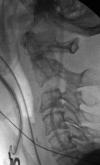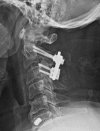Fractures of the axis: a review of pediatric, adult, and geriatric injuries
- PMID: 27686572
- PMCID: PMC5127948
- DOI: 10.1007/s12178-016-9368-1
Fractures of the axis: a review of pediatric, adult, and geriatric injuries
Abstract
Fractures of the second cervical vertebra (C2, axis) are common in adult spine surgery. Those fractures occurring in younger adult patients are often associated with high-energy mechanism trauma, resulting in a "Hangman's Fracture." Management of these fractures is often successful with nonoperative means, though surgery may be needed in those fractures with greater displacement and injury to the C2-C3 disc. Older patients are more likely to sustain fractures of the odontoid process. The evidence supporting surgical management of these fractures is evolving, as there may be a mortality benefit to surgery. Regardless of treatment, longer-term mortality rates are high in this patient population, which should be discussed with the patient and family at the time of injury. Pediatric patients may suffer fractures of the axis, though differentiation of normal and pathologic findings is necessary and more difficult with the skeletally immature spine.
Keywords: Axis; C2; Fracture; Hangman’s; Odontoid; Spondylolisthesis.
Conflict of interest statement
Megan E. Gornet declares that she has no conflict of interest. Michael P. Kelly reports grants paid directly to his institution from the Cervical Spine Research Society, AO Spine, Barnes Jewish Foundation, Fox Family Foundation, Orthopedic Research Education Foundation, Cerapedics, and PCORI, outside the submitted work. Human and animal rights and informed consent This article does not contain any studies with human or animal subjects performed by any of the authors.
Figures








References
-
- Ryan MD, Henderson JJ. The epidemiology of fractures and fracture-dislocations of the cervical spine. Injury. 1992;23:38–40. - PubMed
-
- Lui TN, Lee ST, Wong CW, et al. C1-C2 fracture-dislocations in children and adolescents. J Trauma. 1996;40:408–11. - PubMed
-
- Platzer P, Jaindl M, Thalhammer G, et al. Cervical spine injuries in pediatric patients. J Trauma. 2007;62:389–96. discussion 94-6. - PubMed
-
- Viccellio P, Simon H, Pressman BD, et al. A prospective multicenter study of cervical spine injury in children. Pediatrics. 2001;108, E20. - PubMed
-
- Avellino AM, Mann FA, Grady MS, et al. The misdiagnosis of acute cervical spine injuries and fractures in infants and children: the 12-year experience of a level I pediatric and adult trauma center. Childs Nerv Syst. 2005;21:122–7. - PubMed
Publication types
LinkOut - more resources
Full Text Sources
Other Literature Sources
Miscellaneous

